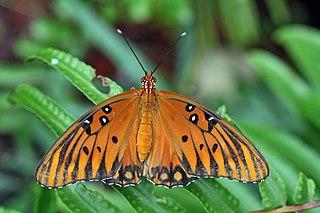
The Gulf fritillary or passion butterfly is a bright orange butterfly in the subfamily Heliconiinae of the family Nymphalidae. That subfamily was formerly set apart as a separate family, the Heliconiidae. The Heliconiinae are "longwing butterflies", which have long, narrow wings compared to other butterflies.
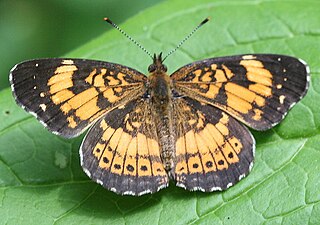
Chlosyne nycteis, the silvery checkerspot, is a species of Nymphalinae butterfly that occurs in North America. It is listed as a species of special concern in Connecticut and Maine, and is believed extirpated in Connecticut, Massachusetts, and New Hampshire.
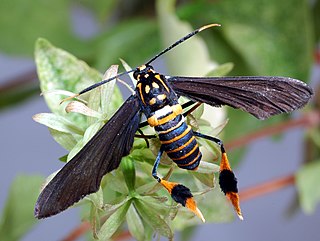
Horama panthalon, the Texas wasp moth, is a moth of the subfamily Arctiinae. The species was first described by Johan Christian Fabricius in 1793. It is found in South America, Central America, Mexico, the Antilles and southern United States.
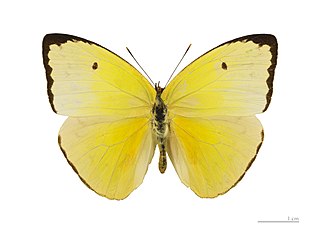
Aphrissa statira, the statira sulphur, is a species of Lepidoptera in the family Pieridae. The species is a medium-sized yellow butterfly, with females more pale than males. They are found from southern regions of Florida and Texas through southern Brazil and northern Argentina. The caterpillars feed on the leaves of several local host plants, while adults prefer to feed on the nectar of red or orange colored flowers. The species is most noted for their dramatic migrations in the tropical areas of the Americas. They have been the subject of many studies about how butterflies navigate and orient during migration.

Anaea troglodyta, the Florida leafwing, Portia or Florida goatweed butterfly, is a butterfly of the family Nymphalidae. It is found in southern Florida and on many islands of the Caribbean. In Jamaica, it is known as the Jamaican tropical leafwing and in the Cayman Islands and Cuba it is known as the Cuban red leaf.

Lerodea eufala, the Eufala skipper or rice leaffolder, is a species of butterfly in the family Hesperiidae. It is found from the coast of Georgia, south through Florida and west across the southern United States to southern California, south through Mexico and Central America to Patagonia. In the summer, it expands its range north to central California, North Dakota, southern Wisconsin, northern Michigan and Washington, D.C.

Anthanassa frisia, the Cuban crescentspot, Cuban checkerspot or Cuban crescent, is a butterfly of the family Nymphalidae. Subspecies tulcis is known by the common names pale-banded crescent or Tulcis crescent; it is treated as a species by some authors.

Erynnis icelus, also known as the dreamy duskywing or aspen dusky wing, is a species of butterfly in the family Hesperiidae. It is found in boreal North America, from the Northwest Territories east across southern Canada to Nova Scotia, south in the western mountains to southern Arizona and southern New Mexico, south in the east to Arkansas, north-eastern Alabama and northern Georgia.

Calpodes ethlius, the Brazilian skipper, larger canna leafroller or canna skipper, is a butterfly of the family Hesperiidae. It is found in the United States from southern Florida and southern Texas, south through the West Indies, Mexico, and Central America to Argentina. Strays and temporary colonies can be found north to southern Nevada, northern Texas, Illinois and Massachusetts.

Wallengrenia otho, the southern broken dash or broken dash skipper, is a butterfly of the family Hesperiidae. It was originally described by Smith in 1797. It is found from eastern Texas and the southeastern United States, south through the West Indies and Central America to Argentina. Strays can be found as far north as central Missouri, northern Kentucky and Delaware.

Atrytone arogos, the arogos skipper or beard-grass skipper, is an endangered species of butterfly of the family Hesperiidae.

Texola elada, the Elada checkerspot, is a species of butterfly in the brush-footed butterfly family, Nymphalidae. It is found from southern Mexico north to central Texas and central Arizona in the United States.
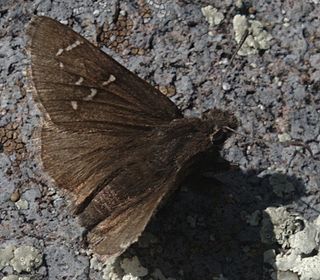
Thorybes mexicana, the Mexican cloudywing, mountain cloudy wing or Nevada cloudy wing, is a butterfly of the family Hesperiidae. It is found in the high elevation mountains of the western United States south into Mexico.

Eurema daira, the fairy yellow, barred yellow or barred sulphur, is a butterfly of the family Pieridae. The species was first described by Jean-Baptiste Godart in 1819. It is found from Argentina north to the southern United States. Strays can be found up to southern Arizona, South Dakota, southern Texas and even Washington, D.C.

Eurema boisduvaliana, commonly known as Boisduval's yellow, is a butterfly in the family Pieridae. It is found from Costa Rica north to Mexico. Rare strays may be found in southern Florida, but it is a regular migrant to south-eastern Arizona, south-western New Mexico, and southern Texas. The habitat consists of subtropical forests and forest edges, scrubs, roadsides and pastures.

Anthanassa is a genus of North and South American butterflies of the family Nymphalidae found from the United States to South America. One authority places this genus as a subgenus of Phyciodes.
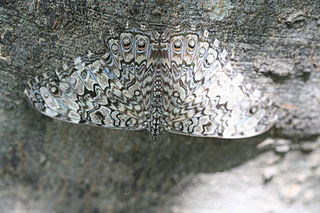
Hamadryas februa, the graycracker, is a species of cracker butterfly in the family Nymphalidae. It is found from Argentina north through tropical America to Mexico. Rare strays can be found up to the lower Rio Grande Valley in southern Texas. The habitat consists of subtropical forests, forest edges and cultivated areas with trees.

Hemiargus ceraunus, the Ceraunus blue, is a species of butterfly in the family Lycaenidae. The species was first described by Johan Christian Fabricius in 1793. It is found in the southwestern United States, southern Texas, Florida and the Florida Keys south through the West Indies, Mexico and Central America to South America. Strays may be found in North Carolina, Missouri, Kansas and Nevada. The habitat consists of open woodland, desert scrub, dunes, pastures, road edges and vacant lots.

Lethe creola, the creole pearly-eye, is a species of brush-footed butterfly in the family Nymphalidae. It is found it the United States from North Carolina and central Georgia west to eastern Oklahoma and eastern Texas. Some authorities include this species in the genus Enodia as Enodia creola.

Anaea are a genus of charaxine butterflies in the brush-footed butterfly family Nymphalidae. The butterflies are commonly known as leafwings. Members of the genus are found throughout the United States, Central America, and the Caribbean.






















